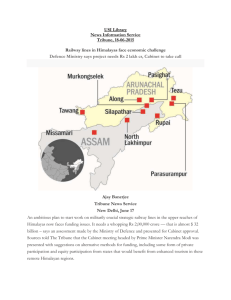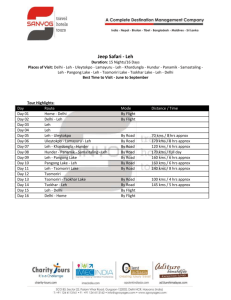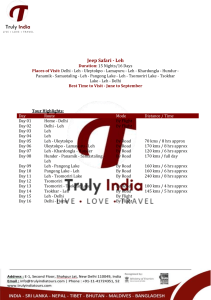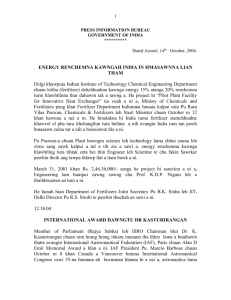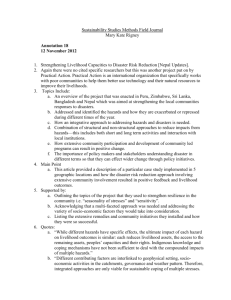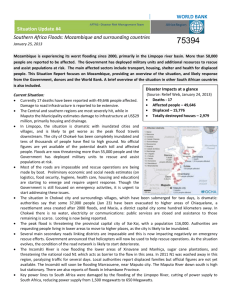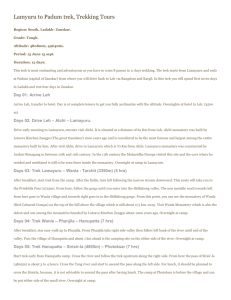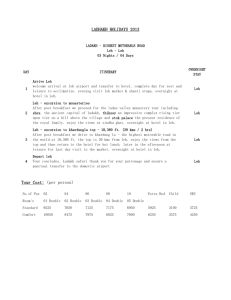Full report
advertisement
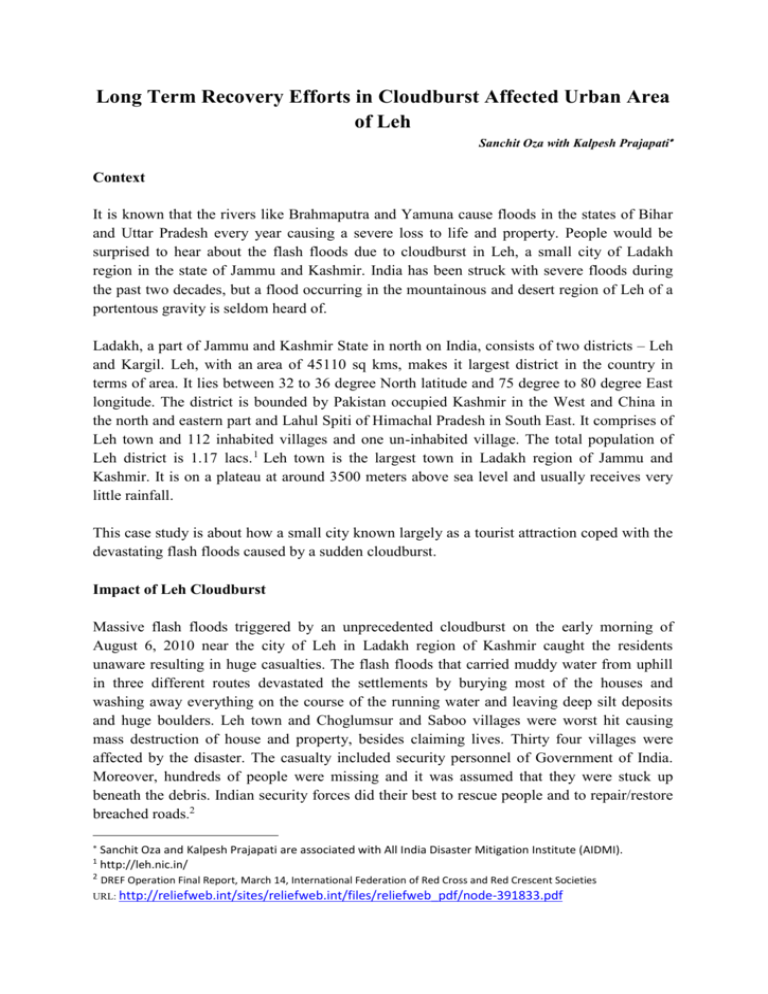
Long Term Recovery Efforts in Cloudburst Affected Urban Area of Leh Sanchit Oza with Kalpesh Prajapati Context It is known that the rivers like Brahmaputra and Yamuna cause floods in the states of Bihar and Uttar Pradesh every year causing a severe loss to life and property. People would be surprised to hear about the flash floods due to cloudburst in Leh, a small city of Ladakh region in the state of Jammu and Kashmir. India has been struck with severe floods during the past two decades, but a flood occurring in the mountainous and desert region of Leh of a portentous gravity is seldom heard of. Ladakh, a part of Jammu and Kashmir State in north on India, consists of two districts – Leh and Kargil. Leh, with an area of 45110 sq kms, makes it largest district in the country in terms of area. It lies between 32 to 36 degree North latitude and 75 degree to 80 degree East longitude. The district is bounded by Pakistan occupied Kashmir in the West and China in the north and eastern part and Lahul Spiti of Himachal Pradesh in South East. It comprises of Leh town and 112 inhabited villages and one un-inhabited village. The total population of Leh district is 1.17 lacs. 1 Leh town is the largest town in Ladakh region of Jammu and Kashmir. It is on a plateau at around 3500 meters above sea level and usually receives very little rainfall. This case study is about how a small city known largely as a tourist attraction coped with the devastating flash floods caused by a sudden cloudburst. Impact of Leh Cloudburst Massive flash floods triggered by an unprecedented cloudburst on the early morning of August 6, 2010 near the city of Leh in Ladakh region of Kashmir caught the residents unaware resulting in huge casualties. The flash floods that carried muddy water from uphill in three different routes devastated the settlements by burying most of the houses and washing away everything on the course of the running water and leaving deep silt deposits and huge boulders. Leh town and Choglumsur and Saboo villages were worst hit causing mass destruction of house and property, besides claiming lives. Thirty four villages were affected by the disaster. The casualty included security personnel of Government of India. Moreover, hundreds of people were missing and it was assumed that they were stuck up beneath the debris. Indian security forces did their best to rescue people and to repair/restore breached roads.2 1 2 Sanchit Oza and Kalpesh Prajapati are associated with All India Disaster Mitigation Institute (AIDMI). http://leh.nic.in/ DREF Operation Final Report, March 14, International Federation of Red Cross and Red Crescent Societies URL: http://reliefweb.int/sites/reliefweb.int/files/reliefweb_pdf/node-391833.pdf Leh, devastated by a massive cloudburst followed by flash floods, witnessed the highest number of casualties. As many as 234 people died in Leh and 424 were seriously injured. Rajouri district in Jammu division witnessed 20 deaths followed by Reasi (11), Islamabad (10), Kathua and Poonch (seven each), Doda and Varmul (five each), Jammu, Udhampur and Kargil (two each) and Budgam and Shopian (one each). Varmul district suffered a loss of Rs. 61 crores in agricultural sector and Rs. 58.22 crores in the horticulture sector, the highest economic loss in the state. Shopian district suffered a loss of Rs. 10.35 crores in the horticulture sector. Both Varmul and Shopian are apple producing regions and a large section of population in these two districts is dependent on the horticulture sector. In the border district of Kupwara, the damage caused due to floods was estimated by the government to be around Rs. 75.40 crores. However, an amount of only Rs. 35 crores out of the State Disaster Response Fund had been released in favour of the divisional and district administrations.3 After the devastation caused by the cloudburst, the Centre released Rs. 5 crores for erecting the pre-fabricated structures, with the National Disaster Management Authority (NDMA) undertaking the work at different locations on sites identified by the State Government and local administration. The NDMA handed over 16 pre-fabricated shelters constructed for people affected by the cloudburst and flash floods from funds released by the Prime Minister's National Relief Fund. NDMA Vice-Chairman, M. Shashidhar Reddy, visited Leh in December 2010 to hand over these structures to Rigzin Spalbar, Chairman and Chief Executive Councilor of Ladhak Autonomous Hill Development Council, to be used for community and educational institutions. He was accompanied by NDMA member, Muzaffar Ahamad. The NDMA, through Hindustan Prefab Ltd., took six weeks to put up the structures amid the challenge to complete it before the onset of winter which is severe in that region.4 Initiative of AIDMI On August 10, 2010, the All India Disaster Mitigation Institute (AIDMI) team landed at Leh to take part in the initial impact assessment of the devastating flash floods as it received request from its year 2002-2003 partner – Centre for Sustainable Development and Food Security in Ladakh (Censfood Ladakh). Censfood Ladakh was registered as a society in 2003 with a mission to work towards promotion of policies, institutions and capacities that strengthen the voice and participation of the poor and marginalized, in improving their socioeconomic status. The organisation is at present working intensively in Leh district of Jammu and Kashmir state. The AIDMI team visited the most affected villages – Choglamsar, Phyang, Taru, Nimmo, Shey, Sakti and Saboo – apart from Leh town new bus station area. AIDMI has continued its approach of working through local partner organizations and thus imparted in the assessment visit along with two local partners of Leh. The prime focus of AIDMI was to conduct on-spot observation of the extent of damage and the possible relief and rescue measures to be taken thereof. 3 4 http://www.greaterkashmir.com/news/2010/Oct/6/300-casualties-in-cloudburst-flash-floods-govt-36.asp http://hindu.com/2010/12/25/stories/2010122565720700.htm During the assessment, it was reflected by all the stakeholders that flash floods accompanied by cloudbursts had caused severe damage to shelter, livelihood, irrigation system, water bodies, and public infrastructures. The individual livelihood damage assessment was carried out by AIDMI with the local partners’ team members, local government, village leader, civil engineer, and community leaders. Based on this assessment, individual, community-based, and group livelihood restoration support was designed and provided. School damage assessment was also carried out with the local partner organization, which covered rural and urban areas and three out of ten schools of Leh town were selected by local partner and local councilor to provide mitigation measures support (structural) for safer environment of education for the children of affected marginalised communities. Moreover, in order to build the capacity of the affected community in reconstruction and rehabilitation, and to make them more self prepared to handle any such event in future, a training strategy was worked out by AIDMI to build their capacities in Disaster Risk Reduction activities. This was done in consultation with the local partners along with the local administration; Institute of Management, Public Administration & Rural Development, J&K (IMPA, J&K); and National Institute of Disaster Management (NIDM). Accordingly, a three-day training programme on Community Managed Disaster Risk Reduction was conducted at Leh involving both, the community members as well as the governmental functionaries. After the workshop, the local community found that District Disaster Management Plan was not yet ready and Leh City Disaster Management Plan was also not ready. More importantly, they found that use of satellite data can help plan recovery better and functional literacy of women in disaster recovery can make recovery faster and sustainable before the upcoming summer. Goals and Objectives Identifying needs of the affected marginalised community members and promote community managed flash flood recovery through involvement of affected marginalised community members, PRI members and local administration through local partners was of utmost significance to AIDMI. These goals came up from the community and with the help of the planning session. The goals aimed at faster and more sustainable recovery of local city economy and of the families affected by the cloudburst. AIDMI’s objectives for the above-mentioned initiative and immediate relief and response to the flash floods and cloudbursts in Leh were twofold: (1) Direct basic and immediate relief of livelihood; and (2) To develop basic conditions for local capacity based long term community recovery and risk reduction through school safety measures. The above two were based on an overview of the local economy and communities, a consultation of local communities and NGOs, Leh’s experience with economic growth in past ten years, and inter-community and inter-sectoral variations. Special attention was paid to inclusiveness and poorer communities. The objectives focused on: Enhancing understanding among partners and affected community about identifying needs of the affected community through inclusive needs assessment and planning response activities accordingly. Involving the affected community in their own long term and sustainable livelihood restoration. Making the partners, community members, PRI members, and government representatives aware about the CMDRR concept through building their capacity and resiliency against disasters thereby resulting in better disaster risk reduction.5 Discussions with Leh city authorities were held to attract resources from JNURM from Government of India for this purpose. Impacts and Results The worst sectors affected in flash floods were shelters and livelihoods. For effective implementation of project activities, consultations with local partner NGOs – operating in Leh – were held and subsequently it was finalized in a multi stakeholder consultation that in addition to NGOs working in Leh, representative of the District Administration, Civil Engineer, village leaders, and members of the affected communities’ experience and opinion should be included in the project implementation. Communities pointed out that, for recovery in Leh to be inclusive, it must create adequate livelihood opportunities and add to quality employment that address expectations of the local communities. The long age structure of Leh city offered a potential demographic dividend for rapid recovery. This possible dividend is dependent on education, skills, and matching investments in employment. Government agencies were not equipped technically as well as manually to deal with disaster of such a massive gravity. Thus, AIDMI, with the local actors, facilitated information collection of community from various flash floods affected areas. Moreover, sector specific assessment forms – shelter, livelihood and school – were developed by AIDMI on the basis of its twenty years experience of relief to long term recovery activities. AIDMI found that new jobs and better jobs during recovery will be in construction, casual labour, self employment, agriculture, and non-farm jobs in villages. Leh can also be a centre for agroprocessing, supply chain management, and increased demand for technical know-how for modernization, maintenance of equipment, and local infrastructure. Local partners, Government officials, and village leaders were glad that they were able to restore livelihood support of the flood affected communities due to which they could restart their livelihood activities to avail maximum benefit of the limited commercial season. This was done by integrating the principle of community based disaster recovery into the action plan. The schools were also identified with local partners and mitigation measure initiatives were also provided for safer structural environment of education to poor and marginalized communities’ children. 5 Leh Response, AIDMI Narrative Progress Report, for period August 2010 – January 2011. Thus, AIDMI’s participatory intervention with local actors proved crucial for the recovery of the people of Leh and to find measures to sustain it. The practice of community based disaster risk reduction also succeeded through the trainings conducted. The Good Practice As the flash floods struck the town of Leh, it caused most destruction to the infrastructure. The schools were also disrupted and damaged to a great extent. The major concern of the government was to bring about a quick recovery. But due to lack of knowledge about coping with a disaster of such gravity the government lacked the effective techniques for quick recovery. AIDMI helped and guided local partners in restoring livelihoods of the poor and marginalized affected community and in implementing its Safer Schools Campaign activities in affected as well as vulnerable schools in Leh. The direction and technique for community based livelihood recovery, school safety, and disaster risk reduction was provided by AIDMI to local NGOs and actors. The livelihood restoration support provided to the flash flood affected communities has helped the government and village leaders in restoring the source of living of the communities, which few other bodies were able to achieve. Community has gained strength in many dimensions in two years and is therefore well placed to achieve faster, sustainable, and more inclusive recovery over years. However, this can not be assumed as economic conditions are very uncertain. Potential for Replication Community based disaster risk reduction and livelihood restoration is of great significance to a community which has faced an unfortunate disaster. During damage assessment and relief distribution, it is important that the community is in the centre and takes more and more decisions as they feel ready and capable, about recovery. AIDMI focussed on this principle while aiding the community of Leh. Advocacy also plays a crucial role in livelihood restoration in cases where the Government strategies and techniques are falling short. Role of the authorities and civil society is to join hands to secure communities during its hardest period. Such developmental approach to humanitarian crisis is especially crucial, and possible and replicable, in spreading urban resilience in India. Sustainable recovery in Leh is ambitious. But it is not impossible. The recovery so far in Leh town has resulted in citizens of Ladakh having higher expectations. The recovery efforts ahead have to meet aspirations of young men and women of Leh. All sections of society have to adopt new ways to recover.
